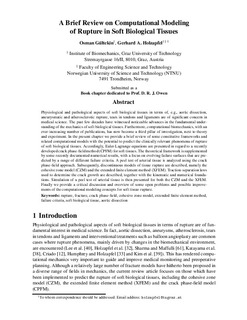| dc.contributor.author | Gultekin, Osman | |
| dc.contributor.author | Dal, Husnu | |
| dc.contributor.author | Holzapfel, Gerhard | |
| dc.date.accessioned | 2019-02-15T14:30:39Z | |
| dc.date.available | 2019-02-15T14:30:39Z | |
| dc.date.created | 2018-12-10T11:15:18Z | |
| dc.date.issued | 2018 | |
| dc.identifier.citation | Computational Mechanics. 2018, 1-11. | nb_NO |
| dc.identifier.issn | 0178-7675 | |
| dc.identifier.uri | http://hdl.handle.net/11250/2585764 | |
| dc.description.abstract | Quasi-incompressible behavior is a desired feature in several constitutive models within the finite elasticity of solids, such as rubber-like materials and some fiber-reinforced soft biological tissues. The Q1P0 finite element formulation, derived from the three-field Hu–Washizu variational principle, has hitherto been exploited along with the augmented Lagrangian method to enforce incompressibility. This formulation typically uses the unimodular deformation gradient. However, contributions by Sansour (Eur J Mech A Solids 27:28–39, 2007) and Helfenstein et al. (Int J Solids Struct 47:2056–2061, 2010) conspicuously demonstrate an alternative concept for analyzing fiber reinforced solids, namely the use of the (unsplit) deformation gradient for the anisotropic contribution, and these authors elaborate on their proposals with analytical evidence. The present study handles the alternative concept from a purely numerical point of view, and addresses systematic comparisons with respect to the classical treatment of the Q1P0 element and its coalescence with the augmented Lagrangian method by means of representative numerical examples. The results corroborate the new concept, show its numerical efficiency and reveal a direct physical interpretation of the fiber stretches. | nb_NO |
| dc.language.iso | eng | nb_NO |
| dc.publisher | Springer | nb_NO |
| dc.title | On the quasi-incompressible finite element analysis of anisotropic hyperelastic materials | nb_NO |
| dc.type | Journal article | nb_NO |
| dc.type | Peer reviewed | nb_NO |
| dc.description.version | acceptedVersion | nb_NO |
| dc.source.pagenumber | 1-11 | nb_NO |
| dc.source.journal | Computational Mechanics | nb_NO |
| dc.identifier.doi | 10.1007/s00466-018-1602-9 | |
| dc.identifier.cristin | 1640991 | |
| dc.description.localcode | This is a post-peer-review, pre-copyedit version of an article published in Computational Mechanics Locked until 21.07.2019 due to copyright restrictions. The final authenticated version is available online at: https://doi.org/10.1007/s00466-018-1602-9 | nb_NO |
| cristin.unitcode | 194,64,45,0 | |
| cristin.unitname | Institutt for konstruksjonsteknikk | |
| cristin.ispublished | true | |
| cristin.fulltext | postprint | |
| cristin.qualitycode | 1 | |
